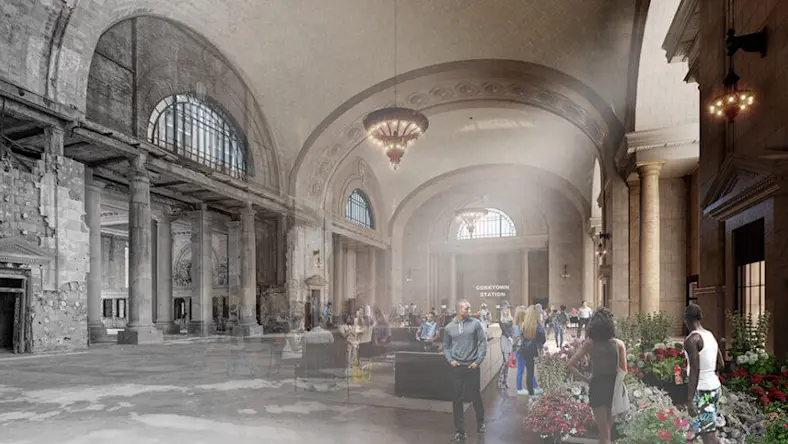& Construction

Integrated BIM tools, including Revit, AutoCAD, and Civil 3D
& Manufacturing

Professional CAD/CAM tools built on Inventor and AutoCAD
Jingdezhen, an ancient and vibrant city in China, is world-renowned as the “porcelain capital” thanks to its millennia-old ceramic craftsmanship and deep ceramic culture. Today, in the heart of Jingdezhen, a new building project is getting a lot of attention—Taoxi Mingzhu is a renovation of the old Jingdezhen Ceramic Factory, which is transformed into a multi-use complex with stores, artists’ studios, and civic spaces.
With its open and interconnected feel and unique architectural style, Taoxi Mingzhu has become a new calling card for the Taoxichuan area, connecting the ancient and the modern, space and people, and history and modern art. After completion, it will be a landmark building, connecting the city’s public spaces and contributing to the development of Jingdezhen’s tourism and culture.
Under the direction of Cui Kai, one of China’s top architectural masters, this abandoned industrial site has been transformed into a multifunctional architectural complex with a total construction area of about 42,800 square meters and a complex, irregular, wave-shaped arch structure. The centerpiece is a colorful, tiled, exposed-concrete arcade that runs through the building, like a “swimming dragon” wandering through the revitalized Taoxichuan area.
Behind the beauty of the innovative design and construction is a challenging journey by the project’s construction team, China Construction First Division Group Huajiang Construction Co.,Ltd. The project’s engineering highlights include its irregular, steep, curved surface, which is 24 meters high and more than 70 meters long. Achieving this unique shape means that every centimeter of the building represents a unique curvature change, with more than 7,000 cross-sectional views. The project posed an unprecedented challenge to the construction team, incorporating a complex steel structure, varied landscape paving, colorful glazed kiln tiles, and the extensive use of new materials, processes, and technologies.
Looking back on the most successful aspects of the Taoxi Mingzhu project, Wan Renwei, director of China Construction First Group subsidiary the BIM Center, says that it was the “true application of digital construction technology” and “full connection between design and construction” that made the construction of this complex and unusual-shaped building possible. Huang Yong, chief engineer of China Construction First Division Group Huajiang Construction Co.,Ltd. says, “Without the simulation and emulation of digital technology, the modeling of unusual shapes based on Revit, and the many applications of various 3D scanning technologies, this kind of masterful construction of unique and complex shapes would be difficult to achieve.”
To create the distinctive shape of the building’s curved arcade, the project team used building information (BIM) technology to carry out 3D modeling, carefully constructing a digital model of the curved keel, then numbering, dividing, and laying it out. To ensure precise changes in the curvature of the keel, the team also used a string-laying robot to carry out precise checks. The project team used visual programming and modeling technology to design the formwork system of the cast-in-place structure, and realized the automatic sorting of the embedded glazed tiles using BIM.
Through the use of Autodesk tools, including Revit, Dynamo, and Navisworks, the three-dimensional design results were applied to the automatic processing of the formwork and the glazed brick and the site construction. The team also verified and optimized the design plan through the comprehensive application of the model in depth, which ensured the precision of the curved surface, the feasibility of the design, and the accuracy of construction.
Taoxi Mingzhu’s central arcade is a feat in itself, involving the meticulous laying of up to 360,000 glazed kiln tiles in five different colors on the 24-meter-high walls. Each custom glazed kiln tile was pre-set with its unique location, which required the team to accurately place the tiles in the design. During this process, the team also had to solve a major technical problem: how to ensure that the tiles would not fall, despite the steel structure interspersed in between them.
After several trials, “we settled on the structural solution of ‘wave-shaped pigmented cast-in-place concrete,’” says Renwei. Based on this, the team first built a model with a sequence of tile colors, then rendered and optimized the details to simulate the visual effect of the tiles under actual lighting. The team then printed the construction blueprint at a scale of 1:1 to ensure that all parties involved could accurately evaluate the design. “The digital bricklaying technology allows each glazed kiln brick tile to have its own precise number,” Renwei says. Precise laying also ensures that all bricks will be completely covered by the poured concrete, without any gaps, and will blend together to create a rich and ever-changing color, giving the viewer a unique visual experience.
To prevent concrete overflow during the pouring stage, the team carried out detailed process simulations at the beginning of the project, effectively preventing concrete leakage and brick contamination while ensuring that the pouring could be done in one pass. Renwei points out that early digital collaboration, visual programming, establishing a custom processing flow from curves to tile templates, and complete testing of the entire process lay a solid foundation for the success of the project. In particular, the combination of BIM 3D visual simulation, CNC engraving and milling, 3D lofting, 3D scanning, mixed reality technologies, and using a cloud collaboration platform enabled the digital model to play a key role throughout the construction process.
In the end, the project was completed ahead of schedule and also saved 1,077 square meters of formwork, 525 cubic meters of concrete, 1,213 square meters of decorative brick auxiliary materials, and 13,769 tons of carbon emissions due to the efficiency gains and one-off molding from using digital technology. According to a statistic from the China Construction Industry Association, the BIM layout technology for glazed tiles in this project has reduced material waste by 19.4%, saving nearly 1.7 million yuan in material costs and shrinking communication time by 70% for all members of the team.
Yong and his team are exploring how to use digital technology to bring new opportunities for preserving historical buildings and towns.
With the accelerated pace of urban renewal in China, a large number of traditional wooden buildings, stone buildings, murals, and historical centers across the country need to be protected and repaired. “We are currently doing research on a series of construction projects that focus on how digital technology can help protect historical towns and their surrounding cultural tourism,” Renwei says. “There are still significant differences between historical buildings and modern buildings, but there are also similarities, so digital technology is a good starting point.”
The protection of ancient buildings requires the integration of diverse digital technologies such as BIM, visual modeling and analysis, and virtual reality (VR) to facilitate more refined management and collaborative work on historic preservation projects. The team also faces the challenge of applying modern technologies to ancient buildings, which involves comprehensively analyzing information building materials and structure to formulate a reasonable protection plan.
Looking back on the experience of the Taoxi Mingzhu project, Yong says that to meet the high standards required for the preservation of more “masterpieces” in the future, the key is determining “how to skillfully incorporate the design concepts of the master architects into the actual construction of the building, treating each building as if it were a work of art carefully crafted with great care.”
To this end, Yong believes that teams must, on one hand, fully embrace the digital production model and make digital technology the “leading department” in cross-team collaboration. At the same time, digital technology should support innovative ways of thinking and working to build reliance on digitalization and confidence in its practical benefits.
Renwei also emphasized the importance of seamless data connection and an efficient collaboration platform when dealing with complex projects. In the future, as new construction technologies and innovative materials emerge, it will be a continuous task to use digital means and modeling capabilities to meet the challenges brought about by complex processes and materials.
Betty Wang is a freelance writer who focuses on technology trends. She specializes in writing stories on technology innovations with rich cultural significance. Her extensive professional experience in technology consulting over the years has given her a deep knowledge and understanding of architecture, software, hardware, and data centers. Wang holds a degree in international journalism from the University of Sheffield, where she developed a forward-looking journalism vision and a unique cultural perspective.
AECO
Image courtesy of Ford Motor Corporation.
AECO
AECO
Image courtesy of Adam Mørk.







